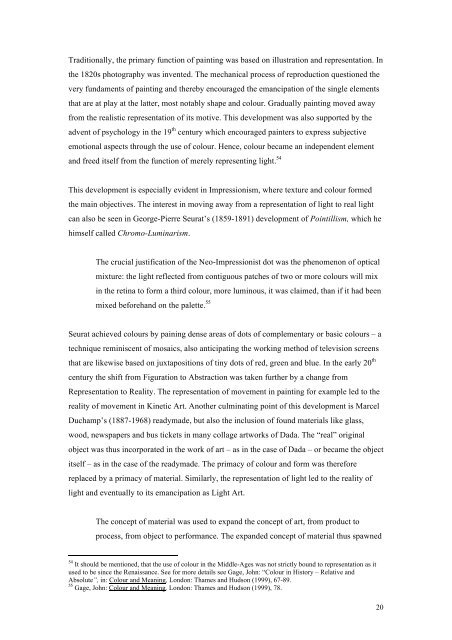Dirty Light - Marko Ciciliani
Dirty Light - Marko Ciciliani
Dirty Light - Marko Ciciliani
You also want an ePaper? Increase the reach of your titles
YUMPU automatically turns print PDFs into web optimized ePapers that Google loves.
Traditionally, the primary function of painting was based on illustration and representation. In<br />
the 1820s photography was invented. The mechanical process of reproduction questioned the<br />
very fundaments of painting and thereby encouraged the emancipation of the single elements<br />
that are at play at the latter, most notably shape and colour. Gradually painting moved away<br />
from the realistic representation of its motive. This development was also supported by the<br />
advent of psychology in the 19 th century which encouraged painters to express subjective<br />
emotional aspects through the use of colour. Hence, colour became an independent element<br />
and freed itself from the function of merely representing light. 54<br />
This development is especially evident in Impressionism, where texture and colour formed<br />
the main objectives. The interest in moving away from a representation of light to real light<br />
can also be seen in George-Pierre Seurat’s (1859-1891) development of Pointillism, which he<br />
himself called Chromo-Luminarism.<br />
The crucial justification of the Neo-Impressionist dot was the phenomenon of optical<br />
mixture: the light reflected from contiguous patches of two or more colours will mix<br />
in the retina to form a third colour, more luminous, it was claimed, than if it had been<br />
mixed beforehand on the palette. 55<br />
Seurat achieved colours by paining dense areas of dots of complementary or basic colours – a<br />
technique reminiscent of mosaics, also anticipating the working method of television screens<br />
that are likewise based on juxtapositions of tiny dots of red, green and blue. In the early 20 th<br />
century the shift from Figuration to Abstraction was taken further by a change from<br />
Representation to Reality. The representation of movement in painting for example led to the<br />
reality of movement in Kinetic Art. Another culminating point of this development is Marcel<br />
Duchamp’s (1887-1968) readymade, but also the inclusion of found materials like glass,<br />
wood, newspapers and bus tickets in many collage artworks of Dada. The “real” original<br />
object was thus incorporated in the work of art – as in the case of Dada – or became the object<br />
itself – as in the case of the readymade. The primacy of colour and form was therefore<br />
replaced by a primacy of material. Similarly, the representation of light led to the reality of<br />
light and eventually to its emancipation as <strong>Light</strong> Art.<br />
The concept of material was used to expand the concept of art, from product to<br />
process, from object to performance. The expanded concept of material thus spawned<br />
54 It should be mentioned, that the use of colour in the Middle-Ages was not strictly bound to representation as it<br />
used to be since the Renaissance. See for more details see Gage, John: “Colour in History – Relative and<br />
Absolute”, in: Colour and Meaning, London: Thames and Hudson (1999), 67-89.<br />
55 Gage, John: Colour and Meaning, London: Thames and Hudson (1999), 78.<br />
20


